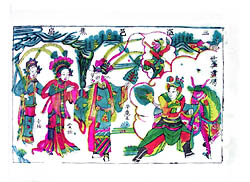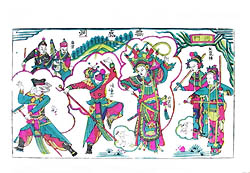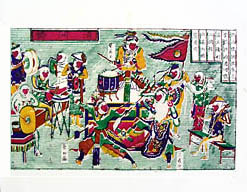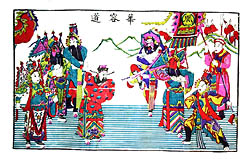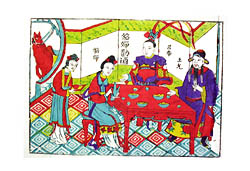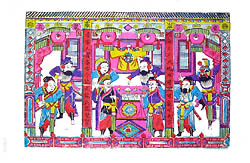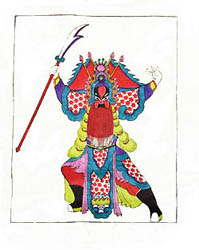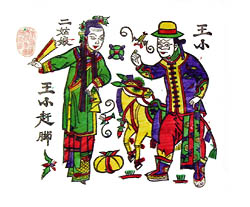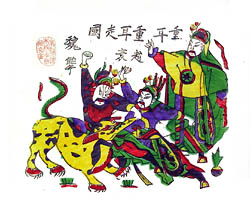The Nianhua Gallery
Theatre and History
Having travelled through North China in the early 1900s, V.M. Alekseev, the Russian folklorist and collector of nianhua, was on hand to witness Chinese theatre at the height of its popularity. He wrote with some obvious enthusiasm:
"There is not a single village in China that is not visited by a theatrical troupe at least a few times a year. I doubt that there is another country in which the love of theatre reflects so much on the life of the people. Without a doubt, China is the most theatrical of nations!"
Interest in the theatrical, moreover, was not limited to the theatre and among the most popular of nianhua prints were those that represented dramas. Even the briefest consideration should demonstrate to the student of Chinese culture that most such prints, and the theatricals that they were based upon, are historical in nature. History and theatre, especially when brought together in the nianhua, were thus often indistinguishable. Whether they appear in a theatre setting or on an ancient battlefield, heroes, villains and damsels always conform to theatrical standards in their postures and costume.
'Monkey Steals the Banana Leaf Fan
(Journey to the West)'
Fengxiang, Shaanxi
'The Bottomless Cave
(Journey to the West)'
Fengxiang, Shaanxi
'Requesting the True Sutra
(Journey to the West)'
Fengxiang, Shaanxi
'Clear River Bridge'
Pingdu, Shandong, NS
'Huarong Road
(Romance of the Three Kingdoms)'
Yangjiabu, Shandong
'At the Sweet Dew Temple
(Romance of the Three Kingdoms)'
Yangjiabu, Shandong
'Diao Chan Serves Wine
(Romance of the Three Kingdoms)'
Yangjiabu, Shandong
'Theatre Scene'
Yangjiabu, Shandong
'Guan Yu
(Romance of the Three Kingdoms)'
Yangjiabu, Shandong
'Nine Dragon Mountain'
Zhuxianzhen, Henan
'Twice Entering the Palace'
Zhuxianzhen, Henan
'Wang Xiao the Donkey Driver'
Zhuxianzhen, Henan
'Zhong Er Leaves His Country'
Zhuxianzhen, Henan

